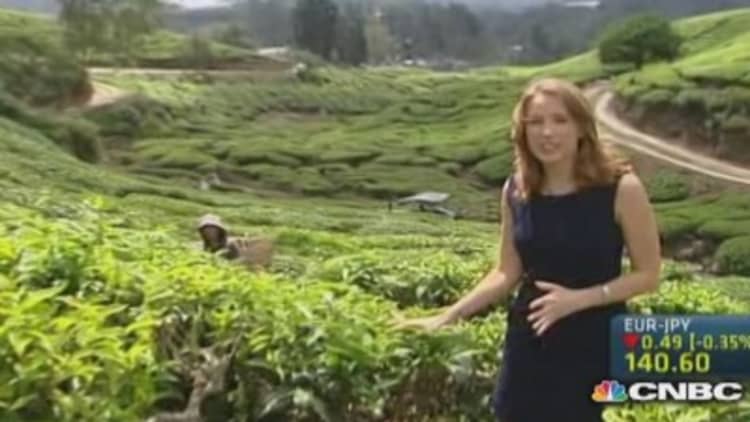
A long dry season in the East has left Asia's premier tea-growing regions parched and could lead to a rise in tea prices, analysts said.
The drought across Sri Lanka in the first three months of 2014 has contributed to a 50 percent fall in tea production on previously corresponding period, industry sources said. Some 400,000 small tea holders in Ratnapura, Kalutara, Galle and Matara districts are among the worst affected, according to The Sri Lanka Tea Board.
Read MoreTiny tropical state joins the extreme weather club
"Sri Lanka is the second largest exporter of tea at 300 million tonnes," said Standard Chartered analyst Nirgunan Tiruchelvam. "In a context where tea prices have been falling – last year tea prices fell 40 percent which was the most precipitous fall in the history of the commodity – it's conceivable that tea prices are going to ascend in this context."
Tea producers in Malaysia have also been hit by drought. At the Boh Plantations in the Cameron Highlands, February's crop declined 50 percent on previously corresponding period.
Changing weather a concern
Caroline Russell, CEO of Boh's Cameron Highlands, says there's evidence to suggest weather patterns are becoming more volatile.
"I think longer term there is a worry about climate change. The view is that in the tropics it is going to create greater levels of inconsistency in rainfall. One will encounter periods that are much drier and periods that are much wetter. Your total annual rainfall may not change very dramatically in the tropics. "However, its distribution will and that will have very serious effects on us," she said.
"In the dry periods, we would see crop yields fall but the concern in very wet periods is that we would see slope instability because we are growing tea on quite steep terrain. Of course you have incidents of landslides under those kinds of conditions, particularly if it comes after a very dry period," she added.

Changing tastes
Caroline believes agricultural over-development in the Cameron Highlands could also have a lasting impact on the flavor of Boh Tea.
"There's been a lot of land clearance for agriculture. This undoubtedly is impacting temperatures. Monitoring has shown a rise in temperatures in the Cameron Highlands, and while it isn't having a direct impact onto us immediately, in the longer term it potentially could. Ultimately one could anticipate that your flavors would be impacted," she said.
Read MoreStarbucks bets on Oprah effect for tea business
But as consumption increasingly shifts to instant tea and tea mixes at the expense of traditional brews, such subtle changes in flavor are becoming less obvious.
"In today's context, particularly here in Malaysia, consumer lifestyles are changing so much that people don't have the same downtime. So, quite a lot of the growth areas in the tea market are in arenas of convenience," she said.
"We see instant tea, for example, and mixes of tea (tea combined with sugars and milk, already packaged) that you merely add hot water to, is a burgeoning market. You might say: 'well now that's not real tea', but there's no right and wrong with tea. Tea is an intensely personal product," she added.

